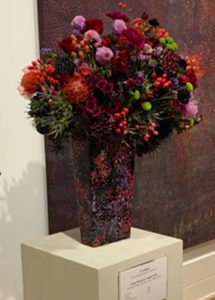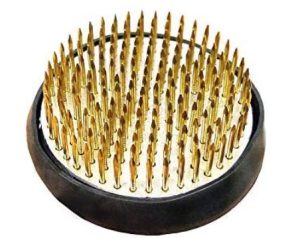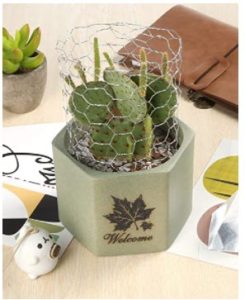Holiday Floral Designs: Fall Flowers Look Florist Perfect
By Elizabeth Cornell Fake, Fairfax Master Gardener
 At the end of the growing season, many gardeners gather up everything left in bloom to bring it inside for holiday bouquets, basket arrangements or wreaths. There is a great temptation to stuff all of the flowers into a plain glass vase filled with water for their final moments of glory. But with some planning, and only a little skill, you can create memorable floral designs. Whether you are using your own flowers or grocery store bunches, here are a few tricks of the floral trade to elevate your floral designs to meet the moment of holiday occasions.
At the end of the growing season, many gardeners gather up everything left in bloom to bring it inside for holiday bouquets, basket arrangements or wreaths. There is a great temptation to stuff all of the flowers into a plain glass vase filled with water for their final moments of glory. But with some planning, and only a little skill, you can create memorable floral designs. Whether you are using your own flowers or grocery store bunches, here are a few tricks of the floral trade to elevate your floral designs to meet the moment of holiday occasions.
Materials Selection
Whether you are using your own garden remnants or selecting supermarket flowers, choose at least six or more different types of flowers and foliage to give the arrangement variety and texture. Choose some large flowers such as garden mums, perennial sunflowers, giant allium, Japanese anemones, gaillardia or oakleaf hydrangeas to serve as focal flowers. Mix in some smaller filler blossoms such as asters, salvia, solidago, popcorn mums and pansies. Then add at least two types of foliage or grasses including supermarket baker’s fern, silver dollar eucalyptus, switch grass, fountain grass and fescue. You can also add foliage with judicious cuttings from your shrubbery and evergreens.
Condition, Condition, Condition
Conditioning is the most important thing you can do to improve the life of your arrangements. Pick blooms in the mid-morning and plunge them into a bucket of warm water immediately. Cut flowers above the thick white part of the stem on a 45-degree angle to promote maximum uptake of water and nutrients. Store the flowers out of direct sunlight in a conditioning solution at least 24 hours before arranging. You can use the packet of white power packed with your grocery store bunch prepared according to the package directions, or you can make your own solution. Begin with a quart of clean, clear water, add 1 tablespoon of sugar for carbohydrate nutrients, 1 teaspoon of household bleach as a disinfectant and 2 teaspoons of lemon juice to keep the water acidic which helps with the uptake of the solution. Once you start conditioning your flowers, you will be amazed at how long they last.
Containers Count
After conditioning, the next most important decision you will make about your arrangement is to choose an appropriate container. A good rule of thumb is to choose a container that adds up in height and width to the size or your tallest flower. For example, if you are going to use sunflowers, find a container whose width and height is the same as the height of the sunflowers you will be using. If the sunflower is 18 inches tall, then your container should be some multiple of height and width adding up to 18 inches. Another guideline to follow concerning container choice is to choose a material that will complement fall flowers. Good choices include wood, galvanized buckets or basins, baskets of any kind, and ceramic or metal vases that have a fall motif.

Floral Needle Holder
If you want to use a fresh pumpkin or other squash as a floral container, keep in mind the pumpkin will begin to decay as soon as you cut it open and carve it for the arrangement. If you decide to use a fresh pumpkin, after carving, wash out the interior with a bleach solution to prevent bacterial growth, then arrange your flowers in another container and place it in the pumpkin. When watering, remove the flower container, water and then replace it to keep the interior of the pumpkin dry. As an alternative, hobby stores and garden centers have a wide array of foam pumpkins, seasonal squashes and gourds that will make a beautiful arrangement and can be used from season to season if stored in a dry location.
A final note on containers is to choose a container that provides a good contrast to the flowers in terms of color or texture. If you are planning to use a wide variety of colorful flowers and foliage, choose a simple, smooth finish, one-color ceramic container that will blend with the array of colors. If you plan to use a container with texture such as driftwood, select simple flowers all the same color to give emphasis to the container rather than the flowers.

Floral Foam
Floral Mechanics
Devices such as floral foam, floral wire, chicken wire, needle holders, rocks and marbles are the structure that holds the design together and will often be the difference between success and failure. Floral foam is a popular choice for floral designers regardless of skill level. It comes in two varieties, wet for fresh flowers and dry for silk or dried flowers. You can buy it online or from craft or hobby stores usually in a package of three bricks. If you plan to use wet foam, it will hold the flowers in place and provide some moisture to keep them fresh for up to a week. Select a brick for your design and soak it in water for at least 15 to 20 minutes making sure it is thoroughly saturated. Cut the block to make a tight fit and push it into your container securing it with green floral tape. Then carefully insert your flowers and foliage into the foam, making sure you puncture the foam only once for each addition. Floral foam works on the principle of tensile strength, which is the capacity of a material to withstand loads. If you make too many holes, it will fall apart. Normally, floral foam can be used only one time, but if you make just a few holes, you can dry it out and use it again. For a second time use, soak it in very hot, almost boiling water to restore the firmness to the block. The only drawback to using floral foam is that it is aesthetically ugly, and most designers try to cover it up completely with greenery or decorative moss. For this reason, it is not a good choice of mechanics for a clear or transparent container.

Chicken Wire
The other mechanical devices listed above can be used multiple times and will last a long time if kept clean and dry between arrangements. Chicken wire is a good choice for large arrangements of flowers with thick stems, and it will bend and conform to an unusually shaped container. Floral wire, a variant of chicken wire, has finer holes and is a good choice for thin stems. Needle holders, which are metal disks with upright spikes, are expensive for the first-time buyer. But if they are carefully cleaned after use and stored in a dry location, they should last for many years. Rocks and marbles provide an inexpensive type of floral mechanics and are best used in clear and transparent containers. Simply pour them into the bottom of a container, cover with water and arrange the flowers. When the flowers have wilted, remove the flowers, pour out the contents, wash in a weak bleach solution to kill any residual bacteria, dry and store in a mesh bag to promote air circulation until time for the next use.
Arrangement Care
Try to avoid placing your arrangements in bright sunlight and water frequently. If you are using a glass vase, pour out the old water after two to three days and add fresh to prevent the bad odor from bacterial growth. Normally your foliage will last longer than the flowers, so it Is a good idea to have some extra flowers for replacements. When both the flowers and foliage have wilted, pull out and discard the floral debris including the floral foam. If you used other mechanics, clean and store them for the future. Finally, wash the container with a mild solution of bleach to kill any remaining bacteria, dry and store for another use.
Resources
• Handy Hints and Tips, Using Floral Foam Effectively, Making
Fresh Flowers Last Longer, Arranging Fresh Flowers, Chrissie Harten, National Association of Flower
Arrangement Societies
• Conditioning, Chrissie Harten, The Gardener, National Association of Flower Arrangement Societies
• Tips for Displaying Cut Flowers, Susan Schoneweis, Home and Environmental Horticulture, University
of Nebraska, Lincoln
• Floral Designs from Your Backyard: Growing, Cutting, and Using Flowers and Shrubs, Lisa Whittlesey,
Texas A&M, AgriLife Extension, Educational Research Center (video)